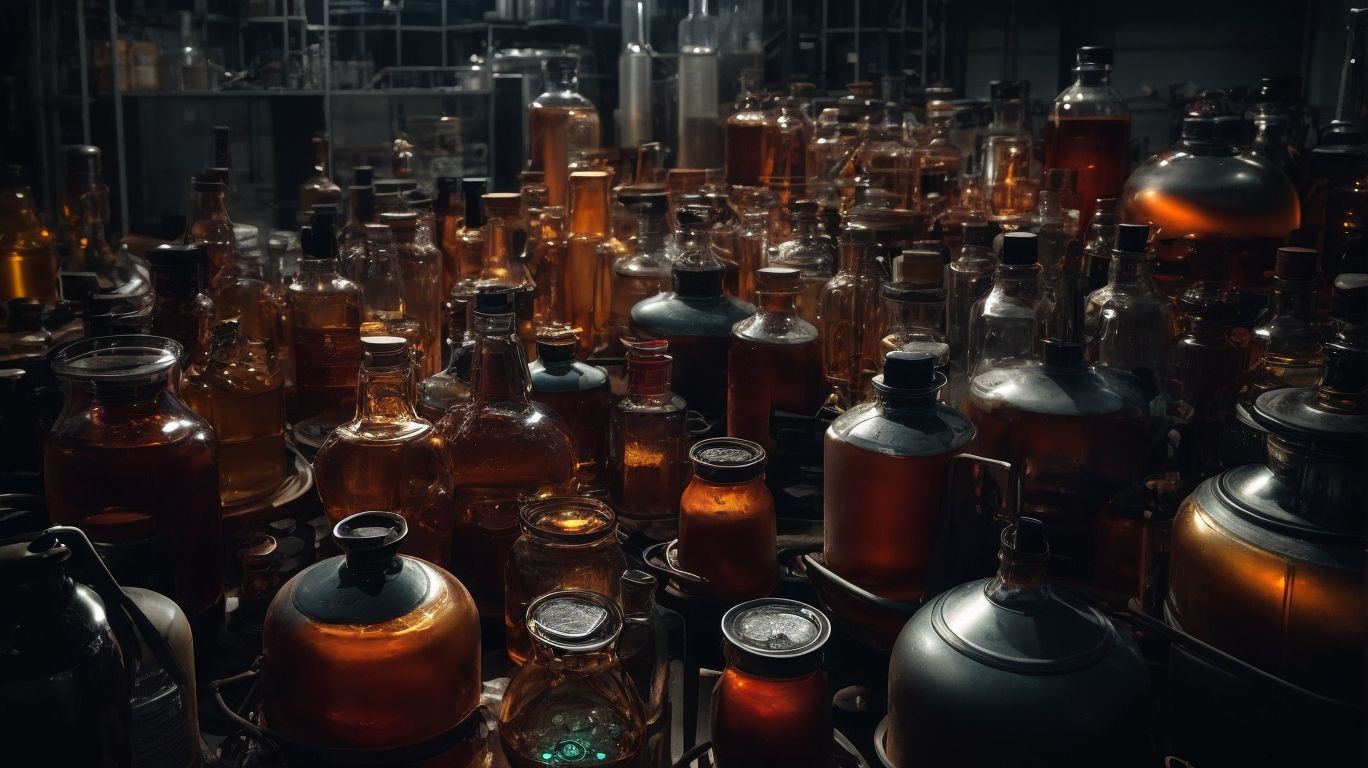Methanol, also known as methyl alcohol or wood alcohol, is a colorless, flammable liquid that is commonly used in various industries and scientific fields. It is one of the simplest alcohols, with a chemical formula of CH3OH, and is produced through the process of gasification of coal, natural gas, or biomass.
This versatile chemical compound has a wide range of applications in the field of science, making it an essential ingredient in many research studies and experiments. Its chemical properties, along with its availability and cost-effectiveness, make it a popular choice for various purposes.
To understand the role of methanol in the scientific community, let’s delve deeper into its properties and common uses.
Methanol has a chemical formula of CH3OH and is composed of one carbon atom, four hydrogen atoms, and one oxygen atom. It is a colorless, odorless, and volatile liquid that is highly soluble in water. Its physical properties, such as its high boiling point and low freezing point, make it suitable for various industrial processes. However, it is also important to note that methanol is highly toxic and can cause serious health problems if ingested.
Methanol is used in a variety of industries, including pharmaceuticals, automotive, and energy, due to its versatile properties. Some of its common uses include:
- As a solvent for paints, resins, and varnishes.
- As a fuel in the production of gasoline and other fuels.
- In the production of chemicals such as formaldehyde and acetic acid.
- In the production of plastics like polyethylene terephthalate (PET).
Methanol’s unique chemical properties also make it a preferred choice for various scientific studies and research. Some of the advantages of using methanol in scientific fields include:
- High octane rating, making it a suitable fuel for high-performance engines.
- Low emissions, making it a greener alternative to traditional fuels.
- Renewable source, as it can be produced from sustainable biomass sources.
However, the use of methanol also comes with potential risks and side effects, such as:
- Toxicity to humans, which can cause blindness, neurological damage, and even death.
- Environmental impact, as it can contaminate water and soil if not handled properly.
- Flammability, making it a hazardous material if not stored and handled correctly.
Despite these risks, methanol continues to have a significant impact in various scientific fields, such as:
- In chemistry research, where it is used as a solvent and reactant in various experiments.
- In biological studies, where it is used to preserve and analyze biological samples.
- In energy research, as it is a potential fuel source for vehicles and other applications.
- In materials science, where it is used in the production of plastics and other materials.
In conclusion, methanol’s diverse properties and applications make it an essential ingredient in the field of science, playing a significant role in advancing research and development in various industries. However, it is crucial to handle this chemical compound with caution and follow proper safety measures to prevent any potential harm.
Key Takeaways:
What is Methanol?
Methanol, or methyl alcohol, is a colorless, flammable liquid with a distinct odor. It is the most basic form of alcohol, consisting of a methyl group attached to a hydroxyl group. Methanol is frequently utilized as a solvent, antifreeze, fuel, and in the creation of formaldehyde and other chemical substances.
For those curious about methanol, there is much to discover regarding its numerous industrial uses, environmental effects, and safety precautions.
How is Methanol Produced?

Photo Credits: Chemicalglossary.Net by Robert Rodriguez
- Extraction: Methanol is mainly produced from natural gas through a process called steam methane reforming, which extracts hydrogen from natural gas.
- Conversion: The extracted hydrogen is then combined with carbon monoxide, obtained from the partial oxidation of natural gas, in the presence of a catalyst to produce methanol.
What are the Properties of Methanol?

Photo Credits: Chemicalglossary.Net by Lawrence Davis
Methanol, also known as wood alcohol, is a versatile compound that has a wide range of applications in the field of science. Before diving into its diverse uses, it is important to understand the fundamental properties of this chemical. In this section, we will discuss the chemical formula of methanol, as well as its physical properties and potential toxicity. By gaining a comprehensive understanding of its properties, we can better appreciate the significance of methanol in various scientific fields.
1. Chemical Formula
The chemical formula of methanol is CH3OH.
2. Physical Properties
- Boiling Point: Methanol has a boiling point of 64.7 ℃, making it a volatile liquid.
- Density: The density of methanol is approximately 0.7918 g/cm³, which is lower than that of water.
- Refractive Index: Methanol has a refractive index of 1.329, indicating its ability to bend light.
3. Toxicity
- Methanol toxicity can occur through ingestion, inhalation, or skin contact.
- Symptoms of toxicity may include headaches, nausea, dizziness, and in severe cases, blindness or death.
- In case of emergency, it is important to seek medical care, ventilate affected areas, and use protective equipment.
- To prevent toxicity, methanol should be stored safely, used in well-ventilated areas, and appropriate protective gear should be worn.
When handling methanol, it is crucial to prioritize safety by following recommended guidelines and seeking professional advice when necessary.
What are the Common Uses of Methanol?

Photo Credits: Chemicalglossary.Net by Andrew Nelson
Methanol, a colorless and volatile liquid, has a wide range of applications in the field of science. From being a solvent to a fuel, it has numerous uses that contribute to advancements in various industries. In this section, we will discuss the common uses of methanol and how it plays a vital role in the production of chemicals and plastics. We will also explore its role as a solvent and a fuel, and how its properties make it a versatile and valuable component in scientific processes.
1. As a Solvent
- Dissolve the solute: Add the substance to be dissolved into the solvent, ensuring it is compatible.
- Stir or agitate: Mix the solvent and solute thoroughly to achieve a homogenous solution.
- Filter if needed: In case of impurities, filter the solution to obtain a pure solvent-solute mixture.
Did you know? As a solvent, methanol is commonly used in the production of pharmaceuticals and various chemical compounds.
2. As a Fuel
- Methanol has various applications as a fuel, including in racing cars, power generation, and fuel cells.
- Methanol is often blended with gasoline to create M85, an alternative fuel for vehicles.
- Methanol fuel cells provide a clean energy source for vehicles and portable electronic devices by generating electricity.
Methanol was first used as a fuel in the 20th century, particularly during World War II when it was used as a motor fuel due to gasoline shortages.
3. In the Production of Chemicals
- Synthesis of formaldehyde: Methanol is a key ingredient in the production of formaldehyde, which is pivotal for manufacturing various products like plywood, paints, and plastics.
- Production of acetic acid: Methanol serves as a vital component in the production of acetic acid, a fundamental chemical used in the manufacture of adhesives, coatings, and fabrics.
- Manufacturing of biodiesel: Methanol is utilized in the production of biodiesel as a catalyst, contributing to the sustainable production of alternative fuels.
Throughout history, methanol has played a significant role in the development of various chemical compounds, revolutionizing industries and scientific advancements. In fact, it has been a crucial component in the production of various chemicals, making significant contributions to the manufacturing of formaldehyde, acetic acid, and biodiesel.
4. In the Production of Plastics
- Polyethylene Terephthalate (PET) Production: Methanol is a key component in the synthesis of PET, a widely used plastic in beverage bottles, food packaging, and synthetic fibers.
- Acrylonitrile Production: Methanol is utilized in the production of acrylonitrile, a precursor for various plastics and synthetic rubber.
- Formaldehyde Production: Methanol serves as a primary raw material in the production of formaldehyde, a crucial building block for manufacturing a range of plastics and resins.
- Urea-formaldehyde Resins: Methanol is employed in the production of urea-formaldehyde resins, which are utilized in the manufacturing of adhesives and molded plastics.
What are the Advantages of Using Methanol?

Photo Credits: Chemicalglossary.Net by Thomas Anderson
Methanol, a colorless liquid with a variety of applications, has been gaining attention in the field of science. Its unique properties make it a versatile tool for various industries, and it is also considered a promising alternative fuel source. In this section, we will delve into the advantages of using methanol, including its high octane rating, low emissions, and renewable source. These qualities make methanol a valuable resource in the pursuit of a more sustainable and efficient future.
1. High Octane Rating
- Methanol boasts a high octane rating, making it the perfect fuel for high-performance engines and racing cars.
2. Low Emissions
- By utilizing methanol, the emissions of greenhouse gases and pollutants are significantly reduced.
- This results in a decrease in carbon monoxide and hydrocarbon emissions, which contributes to a cleaner air quality.
- When used as a fuel, methanol offers lower particulate emissions compared to traditional gasoline.
Fun Fact: Methanol has a higher octane rating than gasoline, making it a valuable component in racing fuel formulations.
3. Renewable Source
- Biomass Conversion: Methanol can be produced from renewable sources such as biomass through gasification, followed by catalytic conversion.
- Carbon Recycling: Utilizing captured carbon dioxide and hydrogen from renewable sources like wind or solar power to produce methanol.
- Syngas Production: Synthesis gas, a mixture of carbon monoxide and hydrogen, can be derived from renewable sources like agricultural waste or wood, then converted to methanol.
What are the Potential Risks and Side Effects of Methanol?
While methanol has various applications in the field of science, it is important to also consider the potential risks and side effects associated with this chemical compound. In this section, we will discuss the diverse ways in which methanol can be harmful to humans, its impact on the environment, and its flammability. By understanding these potential risks, we can make informed decisions about the use and handling of methanol in scientific research and industrial processes.
1. Toxicity to Humans
- Direct Contact: Methanol exposure mainly occurs through skin contact, inhalation, or ingestion.
- Health Effects: It can cause headaches, dizziness, nausea, and in severe cases, blindness or death.
- Treatment: Seek medical attention immediately, as methanol poisoning can be toxic to humans and there is no specific antidote.
Pro-tip: Always use proper personal protective equipment when handling methanol to minimize the risk of exposure.
2. Environmental Impact
Methanol’s impact on the environment is a significant concern due to its toxic effects on aquatic life and potential contamination of soil. Accidental spills during production or transportation can result in pollution of groundwater. However, the low emissions of methanol make it a desirable alternative fuel, reducing the environmental damage caused by traditional gasoline. Additionally, its renewable source characteristic reduces reliance on non-renewable fossil fuels, promoting environmental sustainability.
3. Flammability
- Methanol is known for its high flammability, with a flash point of 11°C, making it a potential fire hazard in many industries.
- Proper handling of methanol is crucial and requires strict safety measures, including the implementation of appropriate storage and fire prevention protocols.
- In the event of a methanol fire, specialized fire-fighting foams or alcohol-resistant foam should be utilized to effectively extinguish the flames.
How is Methanol Used in Different Scientific Fields?

Photo Credits: Chemicalglossary.Net by Patrick Taylor
The versatile compound of methanol has numerous applications in the world of science. Its unique properties and chemical structure make it an essential component in various fields of research. In this section, we will delve into the diverse ways in which methanol is utilized in different scientific disciplines. From chemistry and biology to energy and materials science, we will explore the specific roles that methanol plays in advancing our understanding and capabilities in these areas of study.
1. In Chemistry Research
- Investigating chemical reactions and synthesis processes in the field of chemistry research
- Exploring the properties and behavior of organic and inorganic compounds in the context of chemistry research
- Developing new catalysts and studying their mechanisms for use in chemistry research
Considering these steps can greatly contribute to the advancement of knowledge and application of methanol in chemistry research.
2. In Biological Studies
In the field of biology, methanol is commonly used as a solvent for preparing samples in a variety of laboratory techniques, including protein crystallization, Western blotting, and histology. It is also helpful in preserving and processing biological specimens for microscopic analysis, especially in the study of cells and tissues.
3. In Energy Research
- Developing alternative energy sources using methanol as a fuel.
- Investigating the use of methanol fuel cells for clean energy production in energy research.
- Exploring the potential of methanol as an energy carrier for renewable energy systems in energy research.
4. In Materials Science
In the field of materials science, methanol has various applications. It is commonly used as a solvent in the production of graphene, an important material for flexible electronics. Additionally, it is utilized in the synthesis of metal organic frameworks, which are crucial for gas storage and separation. Furthermore, methanol is a precursor in the production of formaldehyde, a necessary component in the manufacturing of composite materials.
Frequently Asked Questions
What is methanol and what role does it play in the chemical industry?
Methanol is a highly versatile chemical that is essential in the production of various everyday products such as paints, carpets, and plastics. It is considered an essential component of the chemical industry due to its multiple uses and applications.
How is methanol being used in innovative applications to meet the growing energy demand?
Methanol is being used as a fuel for land and marine vehicle combustion, boilers, cookstoves, and kilns, among other market applications. This is due to its ability to be produced from different renewable feedstocks, such as captured CO2 and green hydrogen, making it a net carbon-neutral fuel.
What are the benefits of using methanol as a fuel instead of just a chemical?
Methanol has clean burning properties and can improve fuel efficiency, making it a cleaner alternative to traditional fossil fuels. Its use as a fuel can help reduce emissions and combat climate change, making it an environmentally friendly option.
What makes methanol a valuable chemical and why is its demand increasing globally?
Methanol is used in various industries, including transportation, energy, and manufacturing, making it a crucial component of the global economy. Its versatility and ability to be produced from different feedstocks make it a valuable and in-demand chemical.
How does the production of methanol from renewable feedstocks contribute to a more sustainable future?
The production of methanol from renewable feedstocks helps reduce waste and utilize captured CO2, making it an environmentally friendly option. When produced from renewable feedstocks, methanol becomes a net carbon-neutral fuel, aligning with climate change policies to lower greenhouse gas emissions.
How is methanol helping in the fight against climate change?
Methanol’s use as a fuel can help reduce emissions and lower greenhouse gas emissions, making it a key player in combatting climate change. Additionally, the production of methanol from captured CO2 helps in mitigating the effects of climate change by reducing the amount of greenhouse gases in the atmosphere.
